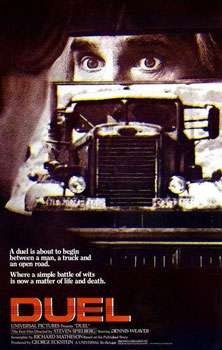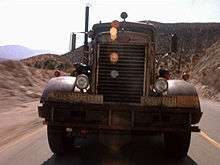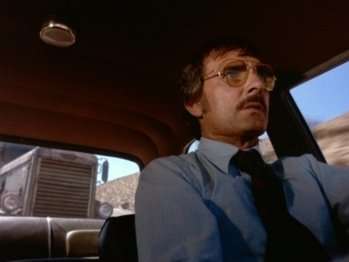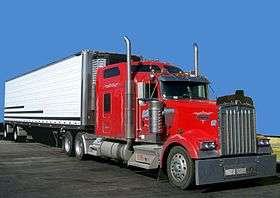Duel (1971 film)
| Duel | |
|---|---|
 Promotional poster (re-release version) | |
| Genre | Thriller |
| Written by | Richard Matheson |
| Directed by | Steven Spielberg |
| Starring | Dennis Weaver |
| Theme music composer | Billy Goldenberg |
| Country of origin | United States |
| Original language(s) | English |
| Production | |
| Producer(s) | George Eckstein |
| Cinematography | Jack A. Marta |
| Editor(s) | Frank Morriss |
| Running time |
74 minutes (TV broadcast) 89 minutes (Theatrical cut) |
| Distributor | Universal Studios |
| Budget | $450,000 |
| Release | |
| Original network | ABC |
| Original release | November 13, 1971 |
Duel is a 1971 television (and later full-length theatrical) thriller film directed by Steven Spielberg in his full-length film directing debut and written by Richard Matheson, based on Matheson's short story of the same name. It stars Dennis Weaver as a terrified motorist stalked on a remote and lonely road by the mostly unseen driver of a mysterious tanker truck.
Plot
David Mann is a middle-aged salesman driving on a business trip. He encounters a grimy tanker truck on a two-lane highway in the California desert, traveling slower than the speed limit and expelling sooty diesel exhaust. Mann passes the truck, but the truck then roars past him and slows down again. Mann overtakes and passes again; the truck blasts its horn and Mann leaves it in the distance.
Mann pulls into a gas station, and shortly after the truck arrives and parks next to him. Mann phones his wife, who is upset with him after an argument the previous night. Several times, the truck driver blasts his air horn, seemingly impatient at waiting to be served by the attendant who is attending to Mann. The gas station attendant refills Mann's car and mentions that it needs a new radiator hose, but Mann refuses the repair.

Back on the road, the truck catches up, passes, and blocks Mann’s path each time he attempts to pass. After antagonizing Mann for some time, the unseen driver waves him past, indicating that it is safe to pass. But Mann attempts to pass and almost strikes an oncoming vehicle. He realizes that the truck driver was trying to trick him into a collision, so he passes the truck again, using an unpaved turnout next to the highway.
The truck tailgates Mann at high speeds, forcing him to maintain his speed to avoid being rear-ended. The truck bumps him several times, then Mann drives his car off the road and collides with a fence opposite a diner. The truck continues down the road, and Mann enters the diner to compose himself. Returning from the restroom, he is shocked to see the truck parked outside. Mann studies the diner patrons and confronts the man who he believes is the truck driver; offended, the driver strikes Mann in the stomach and drives away in a different truck. The pursuing truck leaves seconds later indicating that its driver was never inside the diner.
Mann leaves the diner and stops to help a stranded school bus, but his front bumper becomes caught underneath the bus's rear bumper. The truck appears at the end of a tunnel. Mann panics, manages to free his car, and flees. To Mann's shock and slight chagrin, the truck starts the bus by giving it a push-start to get it moving. Shortly after, Mann is stopped at a railroad crossing when the truck pushes his car toward the path of an oncoming freight train. The train passes just in time; Mann crosses the tracks and pulls off the road. The truck passes and disappears. Mann finds it waiting for him farther down the road.

Mann stops at a gas station to call the police and refuel his car. When he steps into a phone booth, the truck drives into it; Mann jumps clear just in time before getting into his car and speeding away, hiding behind an embankment as the truck drives past.
After a long wait, Mann heads off again but finds the truck waiting for him around the bend. Mann stops his car, then attempts to speed past the stopped truck, but it moves across the road, blocking his way. He approaches the stopped truck on foot, but it drives slowly away, keeping just ahead of him. He seeks help from an older couple in a car, but they flee when the truck backs up towards them at speed. The truck stops before hitting Mann's car, then waves him past.
Mann speeds around the truck and races up steep grades, putting distance between himself and the truck. He sees a black-and-white car parked on the side of the road, thinking that it is a police car. He skids to a stop, but finds that it is a pest control vehicle. The chase continues up a mountain, but Mann's car begins to overheat when its radiator hose fails. He barely makes the summit and coasts downhill in neutral as the truck bears down on him.
Mann spins out and hits a rock wall. The truck speeds toward the car as Mann accelerates, drives up a dirt road, and turns to face his opponent on a hill overlooking a canyon. He places his briefcase on the accelerator and steers toward the oncoming truck, jumping from the car at the last moment. The tanker hits the car, which bursts into flames, obscuring the truck driver's view. The truck plunges over the cliff. Above the wreckage, Mann jumps up and down, laughing with glee and relief, and then sits exhausted at the cliff's edge.
Cast
|
|
Production
The script is adapted by Richard Matheson from his own short story, originally published in Playboy magazine. It was inspired by a real-life experience in which Matheson was tailgated by a trucker while on his way home from a golfing match with friend Jerry Sohl on November 22, 1963, the same day as the John F. Kennedy assassination. The short story was given to Spielberg by his secretary, who reportedly read the magazine for the stories.[1]
Duel was Spielberg's second feature-length directing effort, after his 1971 The Name of the Game NBC television series episode "L.A. 2017". It was two years after directing a segment of the pilot for the anthology television series Night Gallery and several other TV episodes. Duel was initially shown on American television as an ABC Movie of the Week installment. It was eventually released to cinemas in Europe and Australia; it had a limited cinema release to some venues in the United States, while it was widely praised in the UK. The film's success enabled Spielberg to establish himself as a film director.[1]
Much of the movie was filmed in and around the communities of Canyon Country, Agua Dulce, and Acton, California. In particular, sequences were filmed on Sierra Highway, Agua Dulce Canyon Road, Soledad Canyon Road, and Angeles Forest Highway. Many of the landmarks from Duel still exist today, including the tunnel, the railroad crossing, and Chuck's Café, where Mann stops for a break. The building is still on Sierra Highway and has housed a French restaurant called Le Chene since 1980.[2] The "Snakerama" gas station seen in the film appears in Spielberg's comedy film 1941 (1979) as an homage to Duel, with Lucille Benson again appearing as the proprietor.
Production of the television film was overseen by ABC's director of movies of the week Lillian Gallo.[3] The original made-for-television version was 74 minutes long and its filming was completed in 13 days (three longer than the scheduled 10 days), leaving 10 days for editing prior to broadcast as the ABC Movie of the Week. Following Duel's successful TV airing, Universal released the film overseas in 1972. The TV movie was not long enough for theatrical release, so Universal had Spielberg spend two days filming several new scenes, turning Duel into a 90-minute film. The new scenes were set at the railroad crossing, school bus, and the telephone booth. A longer opening sequence was added with the car backing out of a garage and driving through the city. Expletives were also added, to make the film sound less like a television production.
Spielberg lobbied to have Dennis Weaver in the starring role because he admired Weaver's work in Orson Welles' Touch of Evil. Weaver repeats one of his lines from the Welles classic, telling the truck driver in the cafe that he has "another think coming." Interestingly, this phrase is commonly misstated as "another thing coming", as Weaver's character did in Touch of Evil.[4]
In the Archive of American Television website, Spielberg is quoted in an interview given by Weaver as saying: "You know, I watch that movie at least twice a year to remember what I did".[5]
Vehicles
The car was carefully chosen, a red Plymouth Valiant, although three cars were used in the filming. The original release featured a 1970 model with a 318 V-8 engine and "Plymouth" spelled out in block letters across the hood, as well as trunk lid treatment characteristic of the 1970 model; a 1971 model with a 225 Slant Six was also used. When the film was released in theatres and scenes were added, a 1972 model with a 225 Slant Six was added, with the "Plymouth" name on the hood as one emblem. All three cars were dressed with wheel covers available only to Valiant models, only in 1971.
The Valiant's red color was also intentional; Spielberg did not care what kind of car was used in the film, but wanted it to be red to enable the vehicle to stand out in the wide shots of the desert highway.[1]
Spielberg had what he called an "audition" for the truck, wherein he viewed a series of trucks to choose the one for the film. He selected the older 1955 Peterbilt 281 over the current flat-nosed "cab-over" style of trucks because the long hood of the Peterbilt, its split windshield, and its round headlights gave it more of a "face", adding to its menacing personality.[1] Additionally, Spielberg said that the multiple license plates on the front bumper of the Peterbilt subtly suggested that the truck driver is a serial killer, having "run down other drivers in other states".[1] For each shot, several people were tasked to make it uglier, adding some "truck make-up". The shots of the truck are done in such a way as to make it seem "alive" in terms of its attack on Mann.
The truck had twin rear axles, a Cummins NTC 350 turbocharged engine with a 5-speed main transmission, and a 3-speed auxiliary transmission, making it capable of hauling loads over 30 tons and top speeds reaching 75–80 mph. During the original filming, the crew only had one truck, so the final scene of the truck falling off the cliff had to be completed in one take. For the film's theatrical release, though, additional trucks were purchased in order to film the additional scenes that were not in the original made-for-television version (the school bus scene and the railroad crossing scene). Only one of those trucks has survived.[6]
Stock footage of both vehicles was later used in an episode of the television series The Incredible Hulk, titled "Never Give a Trucker an Even Break". Spielberg was not happy about this, but the usage was legal, as the show was produced by Universal and the Duel contract said nothing about reusing the footage in other Universal productions.[7]
The truck was purchased several times. It is currently owned by a truck collector and is on display at Brad's Trucks in North Carolina.[8]
Music
The film's original score was composed by Billy Goldenberg, who had previously written the music for Spielberg's segment of the Night Gallery pilot and his Columbo episode "Murder by the Book," and co-scored Spielberg's The Name of the Game episode "L.A. 2017" with Robert Prince. Spielberg and Duel producer George Eckstein told him that because of the short production schedule, he would have to write the music during filming, and Goldenberg visited the production on location at Soledad Canyon to help get an idea of what would be required. Spielberg then had Goldenberg ride in the tanker truck being driven by stunt driver Carey Loftin on several occasions; the experience terrified the composer, although he did eventually get used to it. Goldenberg then composed the score in about a week, for strings, harp, keyboards and heavy use of percussion instruments, with Moog synthesiser effects but eschewing brass and woodwinds. He then worked with the music editors to "pick from all the pieces (they) had and cut it together (with the sound effects and dialogue)." Much of his score was ultimately not used in the finished film.[9][10] In 2015 Intrada Records released a limited edition album featuring the complete score, plus four radio source music tracks composed by Goldenberg.
Reception
Critical response
The film received many positive reviews and is often considered one of the greatest TV movies ever made.[11][12] On Rotten Tomatoes the film currently has a score of 87% based on 39 reviews with an average rating of 7.7 out of 10.).[13]
Interpretations of Duel often focus on the symbolism of Mann and the truck. Some critics follow Spielberg's own interpretation of the story as an indictment against the mechanization of life, both by literal machines and by social regimentation.[14] The theme of gender performativity in Mann's quest to prove his manhood is another interpretation several observers have noted.[14][15]
Accolades
- Awards
Avoriaz Fantastic Film Festival
- Grand Prize: 1973[16]
- Outstanding Achievement in Film Sound Editing: 1972[17]
- Nominations
- Best Movie Made for TV: 1972[18]
- Outstanding Achievement in Cinematography for Entertainment Programming – For a Special or Feature Length Program Made for Television: 1972[19]
- Best DVD Classic Film Release: 2005[20]
References in other works
In film
- The dinosaur roar sound effect that is heard as the truck goes over the cliff is also heard in Jaws (1975), also directed by Spielberg, as the shark's carcass sinks into the ocean. Spielberg has said that this is because he feels there is a "kinship" between Duel and Jaws, as they are both about "these leviathans targeting everyman." He has also said that inserting the sound effect into Jaws was "my way of thanking Duel for giving me a career."[1]
- The 1978 anime film Lupin III: The Mystery of Mamo parodies Duel by depicting a chase scene whereby lead characters Arsène Lupin III, Daisuke Jigen and Goemon Ishikawa XIII, driving in a red Austin Cooper, are pursued by a giant Kenworth W900 sent by the film's villain, Mamo, to eliminate them.[21]
- The truck from Duel is seen in the film Torque (2004) and causes a biker to wipe out shortly after a red 4-door Valiant had driven past the bikers.
- In Fire Down Below, the scene where Taggart is chased and nearly run off the road before luring the truck to ram his truck off of a cliff is directly inspired by Duel.
- Barcelona-based Spanish filmmaker Enric Folch, crowdfunded the documentary film The Devil on Wheels.[22] The documentary centers the development of Duel.[23][24]
- The 2001 film Joy Ride is heavily influenced by Duel and contains many direct references. In one scene a similar model truck menaces the protagonists, but the driver is revealed to be harmless.
- The 2015 film Wrecker starring Drea Whitburn and Anna Hutchison is almost a shot for shot remake of Duel.
In print
- The Mr. Monk book Mr. Monk on the Road features a similar sub-plot in which Adrian Monk, driving a rented RV, is pursued by a truck like that from Duel, which meets a similar end, although the truck driver's motive is known.
- In the third part of JoJo's Bizarre Adventure, Stardust Crusaders, the Wheel of Fortune chapters have various references to the movie, as the protagonists must deal with an assassin controlling a car (which resembles a Plymouth).
- In 2009, writers Stephen King and Joe Hill decided to honor Matheson's classic with an homage prose story titled "Throttle." In time, this was turned into a four-issue miniseries called "Road Rage". IDW Publishing gave both "Duel" and "Throttle" two issues each to find a new audience with their comic book adaptation. "Road Rage" #1 was released to the public on Feb 15th, 2012.[25]
In television
- Stock footage from Duel appears throughout The Incredible Hulk first season episode "Never Give a Trucker an Even Break" (originally airdate on CBS: April 28, 1978).[26] Spielberg was reportedly "not too happy about it," according to Matheson.[27]
- In the Red Dwarf series 8 episode "Only the Good...", Arnold Rimmer claims that a scar on the right side of his neck resulted from a friend's attacking him with the video case from the film Duel.
- The opening scene of the Transformers: Prime episode "Nemesis Prime" pays homage to Duel.
- The one-hour special Tiny Toons' Night Ghoulery features a parody segment of the film named "Fuel" with Calamity Coyote.
- The Bob's Burgers season 4 episode "Christmas in the Car" contains numerous Duel references when Bob is terrorized by a candy-cane shaped truck.
- In the television murder mystery series Murder, She Wrote episode "The Cemetery Vote", Jessica is traveling along a country road as a passenger in a station wagon when they are chased and rammed by a large powerful truck covered in mud with the driver invisible behind a mud-caked windshield.
- It was the movie of the week for the Svengoolie program on 11/5/16, his first airing of the film. [28]
In music
- The image of the truck pushing the Plymouth over the cliff is seen on the cover of the album Smokin' Taters! by Kentucky-based band Nine Pound Hammer.
- The Swervedriver song "Duel" from their album Mezcal Head was named after the film.[29]
- In David Lee Roth's (1994) music video "She's my Machine", the truck appears several times.
In computer games
- In Hard Truck: 18 Wheels of Steel, the "Rusty" truck was based on the truck from Duel.
- In Euro Truck Simulator 2, the Peterbilt 351 and its interiors (mods, not part of the vanilla game) are based on the truck from the movie. It may come back in American Truck Simulator as both a 281 and as a 351.
- In Grand Theft Auto V, a random encounter is based on the film.
- In 18 WOS PTTM, the truck appears as a very rare, exclusive mod since its upload in 2006.
References
- 1 2 3 4 5 6 Duel: Special Edition DVD (2005)
- ↑ "Le Chene French Cuisine". lechene.com. Retrieved January 9, 2009.
- ↑ "Lillian Gallo, Pioneering TV Producer, Dies at 84". The Hollywood Reporter. June 18, 2012. Retrieved June 26, 2012.
- ↑ Wertheimer, Linda (January 5, 2013). "Another Think Coming? Scrutinizing An Oft-Misused Phrase". NPR. Retrieved September 3, 2015.
- ↑ "On starring in the TV movie Duel". Academy of Television Arts & Sciences Foundation. Retrieved August 15, 2010.
- ↑ "Fan site for trucks used in film". Retrieved September 3, 2011.
- ↑ Jackson, Kathi (2007). Steven Spielberg: A Biography. Greenwood Publishing Group. p. 18.
- ↑ "The Surviving Duel Truck". Retrieved September 3, 2011.
- ↑ Jon Burlingame, pp. 297-298, TV's Biggest Hits: The Story Of Television Themes From "Dragnet" To "Friends", Schirmer Books, 1996, ISBN 0-02-870324-3
- ↑ "Intrada Soundtrack Forum • View topic - INTRADA Announces Billy Goldenberg's DUEL".
- ↑ "The Best Made-For-TV Movies of All Time". February 7, 2012.
- ↑ "The 15 Best TV Movies Of All Time1. Duel (1971)".
- ↑ http://www.rottentomatoes.com/m/1006345-duel/ Duel at Rotten Tomatoes
- 1 2 Gordon, Andrew (1989) Empire of Dreams: The Science Fiction and Fantasy Films of Steven Spielberg
- ↑ Moscovitz, Jean-Jacques (2012) Letter from a Psychoanalyst to Steven Spielberg
- ↑ "IMDB 1973". Retrieved October 4, 2014.
- ↑ "Emmy 1972". Television Academy. Retrieved October 4, 2014.
- ↑ Golden Globe 1972 Archived November 24, 2010, at the Wayback Machine.
- ↑ "Emmy 1972". Television Academy. Retrieved October 4, 2014.
- ↑ Saturn Awards 2005 Archived November 20, 2011, at the Wayback Machine.
- ↑ Toole, Mike (2012). The Mystery of Mamo (Why Mamo Matters). Discotek Media.
- ↑ ""The Devil On Wheels" Doc to Celebrate Steven Spielberg's 'Duel' - Bloody Disgusting!". March 4, 2015.
- ↑ "Duel Doc Devil on Wheels Drives to Kickstarter - Dread Central". March 4, 2015.
- ↑ "Documentary The Devil on Wheels Pays Tribute to Spielberg's Duel - Dread Central". February 13, 2015.
- ↑ "Road Rage #1".
- ↑ ""The Incredible Hulk" Never Give a Trucker an Even Break (TV Episode 1978) - Trivia - IMDb". IMDb. Retrieved October 4, 2014.
- ↑ Bradley, Matthew. Richard Matheson on Screen: A History of the Filmed Works; 2010, page 70.
- ↑ "Svengoolie".
- ↑ Thill, Scott (16 June 2011). "Space-Walking Through Swervedriver's Sci-Fi Sonics". Wired (magazine). Retrieved 4 March 2016.
‘Duel‘ and ‘The Hitcher‘ were both named after the classic car movies, of course.
Sources
- "Steven Spielberg and Duel: The Making of a Film Career" by Steven Awalt, Rowman & Littlefield (2014).
- The Complete Spielberg by Ian Freer, Virgin Books (2001).
- Steven Spielberg by James Clarke, Pocket Essentials (2004).
- Steven Spielberg The Collectors Edition by Empire Magazine (2004).
- The Steven Spielberg Story by Tony Crawley, William Morrow (1983).
- Duel by Richard Matheson, Tor Books Terror Stories Series (2003).
External links
| Wikiquote has quotations related to: Duel (1971 film) |
- Duel at the Internet Movie Database
- Duel at the TCM Movie Database
- Duel (1971 film) at DMOZ
- From Director Steven Spielberg: Duel archive
